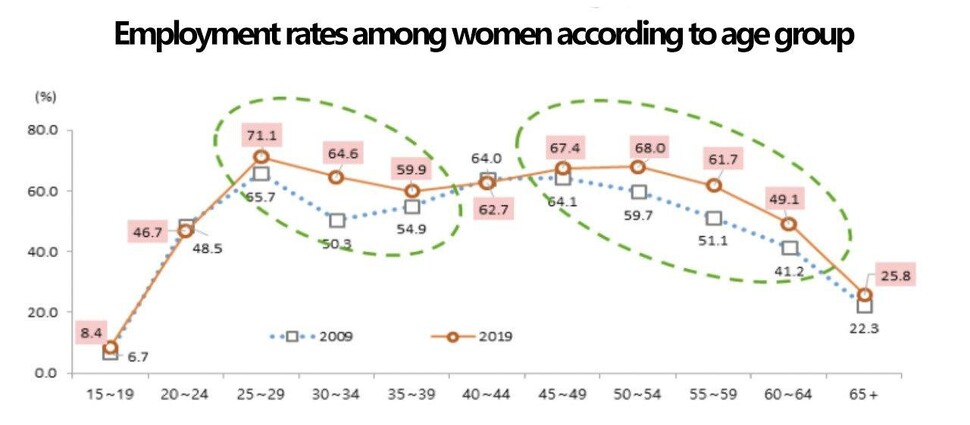hankyoreh
Links to other country sites 다른 나라 사이트 링크
Women spend average of 3.4 times more on household chores in dual income households

Women spent an average of three times more time on housework than men in dual income households in South Korea last year, statistics show. Hourly wages for female workers were also found to average 69% of those for male workers.
On Sept. 2, Statistics Korea and the Ministry of Gender Equality and Family (MOGEF) published a report on “Women’s Lives in 2020 as Seen through Statistics.” The findings showed that women in dual income households spent an average of three hours and seven minutes per day on household chores in 2019, or two hours and 13 minutes more than the 54 minutes spent on average by men. Compared with five years earlier in 2014, the numbers were 0.06 hours lower for women and 0.13 hours higher for men.
In households where only the husband worked, women averaged five hours and 41 minutes per day of housework, compared with 53 minutes for men. The number indicates that men spend roughly the same time on housework regardless of whether their spouse works. In cases of households where only the wife worked, women still spent more time on housework at two hours and 36 minutes, compared with one hour and 59 minutes for men.
The employment rate for women stood at 51.6% last year, 19.1 percentage points lower than the 70.7% rate for men. The difference has narrowed slightly in the 10 years since 2009, when the employment rate gap between women and men was 22.4 percentage points.
The highest employment rate for women was observed among those in their late 20s at 71.1%. The rates dropped to 64.6% for those in their early 30s and 59.9% for those in their late 30s due to women leaving their jobs to marry and to bear and raise children. The rate rose again to 62.7% for those in their early 40s, 67.4% for those in their late 40s, and 68% for those in their early 50s, resulting in an overall “M-shaped” trend. At the same time, the proportion of married women quitting their jobs to raise a family fell slightly from 22.2% in 2014 to 19.2% last year.
The average hourly wage for female salaried workers last year was 16,358 won (US$13.76), or 69.4% of the average for males. The ratio had improved slightly from 2017 (65.9%) and 2018 (67.8%). Female regular workers earned an average hourly wage of 17,565 won (US$14.77), while female irregular workers made 76% of that at 13,417 won (US$11.28).
In terms of the proportion of female managers at companies in 2019, the 18.8% rate for public institutions was up by 1.5 percentage points from 17.3% the year before, while the 20.9% rate for private businesses was down by 0.6 percentage points from 21.5% in 2018. As of 2019, 16.2% of Level 4 civil servants or higher employed by the state were women, an increase of 1.6 percentage points from 14.6% in 2018. The percentage of women among high-ranking civil servants remained unchanged from the year before at 5.5%.
Of the 5,925 reported victims of illegal filming in 2018, 82.9% were women. The total number of cases was down slightly from 6,465 in 2017, but 23% higher (1,102 cases) than the 4,823 reported in 2013.
By Lee Kyung-mi, staff reporter
Please direct comments or questions to [english@hani.co.kr]

Editorial・opinion
![[Column] Has Korea, too, crossed the Rubicon on China? [Column] Has Korea, too, crossed the Rubicon on China?](https://flexible.img.hani.co.kr/flexible/normal/500/300/imgdb/original/2024/0419/9317135153409185.jpg) [Column] Has Korea, too, crossed the Rubicon on China?
[Column] Has Korea, too, crossed the Rubicon on China?![[Correspondent’s column] In Japan’s alliance with US, echoes of its past alliances with UK [Correspondent’s column] In Japan’s alliance with US, echoes of its past alliances with UK](https://flexible.img.hani.co.kr/flexible/normal/500/300/imgdb/original/2024/0419/2317135166563519.jpg) [Correspondent’s column] In Japan’s alliance with US, echoes of its past alliances with UK
[Correspondent’s column] In Japan’s alliance with US, echoes of its past alliances with UK- [Editorial] Does Yoon think the Korean public is wrong?
- [Editorial] As it bolsters its alliance with US, Japan must be accountable for past
- [Guest essay] Amending the Constitution is Yoon’s key to leaving office in public’s good graces
- [Editorial] 10 years on, lessons of Sewol tragedy must never be forgotten
- [Column] A death blow to Korea’s prosecutor politics
- [Correspondent’s column] The US and the end of Japanese pacifism
- [Guest essay] How Korea turned its trainee doctors into monsters
- [Guest essay] As someone who helped forge Seoul-Moscow ties, their status today troubles me
Most viewed articles
- 1[Column] The clock is ticking for Korea’s first lady
- 2After 2 months of delayed, denied medical care, Koreans worry worst may be yet to come
- 3Hong Se-hwa, voice for tolerance whose memoir of exile touched a chord, dies at 76
- 4[Column] Has Korea, too, crossed the Rubicon on China?
- 5US overtakes China as Korea’s top export market, prompting trade sanction jitters
- 6Samsung barricades office as unionized workers strike for better conditions
- 7[Editorial] As it bolsters its alliance with US, Japan must be accountable for past
- 8[Correspondent’s column] In Japan’s alliance with US, echoes of its past alliances with UK
- 9All eyes on Xiaomi after it pulls off EV that Apple couldn’t
- 10[Correspondent’s column] The US and the end of Japanese pacifism